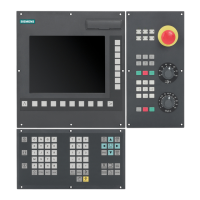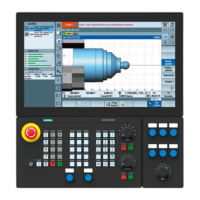Path traversing behavior
9.3 Curve tables (CTAB)
Job planning
9-16 Programming Manual, 03/2006 Edition, 6FC5398-2BP10-1BA0
Example of the definition of a periodic curve table
Definition of a periodic curve table with number 2, master value range 0 to 360, following
axis motion from 0 to 45 and back to 0:
N10 DEF REAL DEPPOS
N20 DEF REAL GRADIENT
N30 CTABDEF(Y,X,2,1) ;Beginning of definition
N40 G1 X=0 Y=0
N50 POLY
N60 PO[X]=(45.0)
N70 PO[X]=(90.0) PO[Y]=(45.0,135.0,-90)
N80 PO[X]=(270.0)
N90 PO[X]=(315.0) PO[Y]=(0.0,-135.0,90)
N100 PO[X]=(360.0)
N110 CTABEND ;End of the definition
;Test of the curve by coupling Y to X
N120 G1 F1000 X0
N130 LEADON(Y,X,2)
N140 X360
N150 X0
N160 LEADOF(Y,X)
;Read the table function for
;master value 75.0
N170 DEPPOS=CTAB(75.0,2,GRADIENT)
;Positioning of the leading and the
;following axis
N180 G0 X75 Y=DEPPOS
;After activating the coupling, no
;synchronization of the following axis
;is required
N190 LEADON(Y,X,2)
N200 G1 X110 F1000
N210 LEADOF(Y,X)
N220 M30
Definition of a curve table
CTABDEF, CTABEND
A curve table represents a parts program or a section of a parts program, which is enclosed
by CTABDEF at the beginning and CTABEND at the end.
Within this parts program section, unique trailing axis positions are assigned to individual
positions of the leading axis by traverse statements and used as intermediate positions in
calculating the curve definition in the form of a polynomial up to the 5th order.

